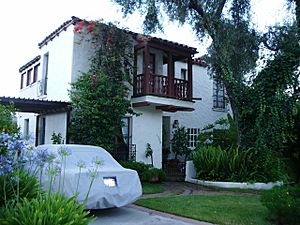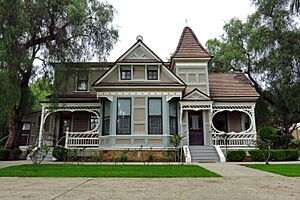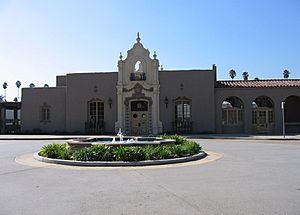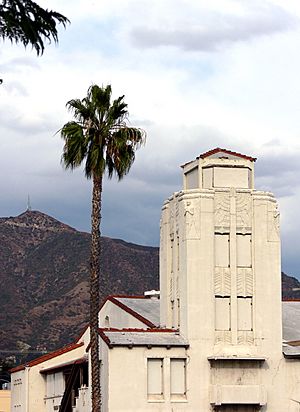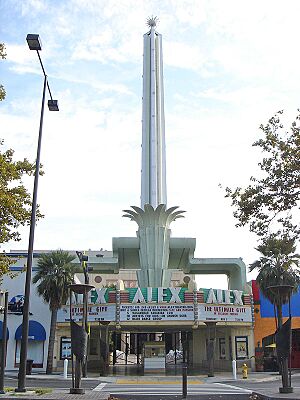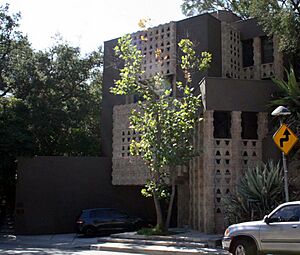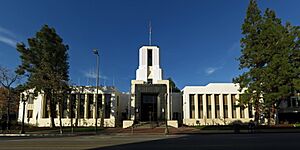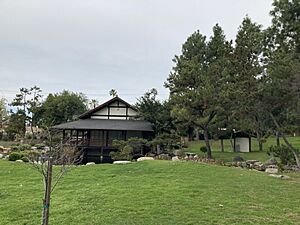Glendale Register of Historic Resources and Historic Districts facts for kids
The Glendale Register of Historic Resources and Historic Districts is a special list of important places in Glendale, California. It includes buildings, bridges, statues, and even trees that the city wants to protect because they have a lot of history. Think of it like a hall of fame for Glendale's oldest and most interesting spots!
Glendale started its program to save historic places in 1977. Back then, 28 properties were named city landmarks. In 1997, the official Glendale Register was created, and it now has over 100 amazing places.
The city also has five special historic neighborhoods, called historic districts. These areas, like Ard Eevin Highlands and Royal Boulevard, have many old homes that show how Glendale used to look. The program for these districts began in 2006.
Some of Glendale's historic places are so important that they are also listed on the National Register of Historic Places (NRHP), which is a national list! For example, the Alex Theatre and the Grand Central Air Terminal are on both lists. The Catalina Verdugo Adobe is extra special because it's on the Glendale Register, the National Register, and is even a California Historical Landmark!
You can find a map of these historic places by clicking "OpenStreetMap" in the box to the right.
Contents
Glendale's Historic Treasures
What is the Glendale Register?
The Glendale Register helps make sure that important historical places are kept safe for future generations. It means these buildings and sites are recognized for their special past and unique design. By protecting them, Glendale keeps its history alive and visible for everyone.
Famous Places on the Register
Many interesting places are on Glendale's historic list. Here are a few examples:
- Catalina Verdugo Adobe: This old adobe house was built around 1860. It was home to Catalina Verdugo, whose family owned a huge ranch called Rancho San Rafael. It's one of the oldest buildings in Glendale and has a rich history.
- Oak of Peace: This was a very large oak tree where important discussions happened in 1847. Leaders talked about ending the Mexican–American War in California under its branches. Even though the tree died in 1987, its remnants are still a historic spot.
- Doctors House: This beautiful Victorian house was built in 1887. It's called the Doctors House because two famous Glendale doctors lived there at different times. It was moved to Brand Park in the 1980s and is now a museum!
- El Miradero: Also known as Brand Library and Brand Castle, this amazing Moorish-style mansion was built in 1903 by Leslie Coombs Brand. He named it "Miradero," which means "The Overlook." Today, it's a library and art center in Brand Park.
- Glendale Southern Pacific Railroad Depot: This train station was built in 1923. It has a beautiful design, mixing Mission Revival and Spanish Colonial Revival styles. It's a reminder of when trains were a main way to travel.
- Grand Central Air Terminal: Built in 1928, this air terminal has a cool Spanish Colonial Revival and Zig-Zag Moderne design. Many famous pilots, like Charles Lindbergh and Amelia Earhart, used this airport!
- Alex Theatre: This grand theater opened in 1925. It has a mix of Classical Revival and Egyptian Revival styles. A tall, neon-lit art-deco column was added in 1940, making it a famous landmark in Glendale.
- James Daniel Derby House: This unique house was built in 1926. It was designed by Lloyd Wright (the son of famous architect Frank Lloyd Wright) in an American Modernistic style with Mayan features. It's made with special pre-cast concrete blocks.
- Glendale City Hall: This important building, where Glendale's government works, was built between 1940 and 1941. It features the sleek and stylish Art Deco architectural design.
- Shoseian Teahouse: Located in Brand Park, this peaceful Japanese teahouse was built in 1974. It's also known as the Shoseian Whispering Pine Japanese Tea House and offers a quiet place for reflection.
Glendale's Historic Neighborhoods
Glendale has five historic districts, which are entire neighborhoods with many old and special homes. These districts help keep the unique look and feel of these areas.
- Royal Boulevard: This was Glendale's first historic district. It has about 30 houses built between 1927 and 1948. You can see homes with Spanish Colonial Revival, Tudor Revival, and French-inspired designs here.
- Ard Eevin Highlands: This neighborhood has 87 homes, mostly built from the 1920s to the 1940s. It features Spanish Colonial, Monterey, Colonial, and Tudor Revival styles.
- Cottage Grove: This district feels like a charming "English village" with 14 homes, mainly Tudor Revival cottages. It also includes a farmhouse from 1901, which was the very first building in the area!
- Brockmont Park: This area has 58 houses built on what used to be a large estate. The original estate home, "Brockmont," and a four-story clock tower from 1914 are key parts of this district.
- Rossmoyne: This is Glendale's largest historic district, with 503 houses! Most were built between 1923 and 1950, showing off Spanish Colonial Revival, Tudor Revival, and French designs.
Why is History Important?
Protecting these historic places helps us understand Glendale's past. Each building, bridge, or tree tells a story about the people who lived here before us and how the city grew. It's like having a giant history book spread out across the city, waiting for you to explore!
Images for kids


